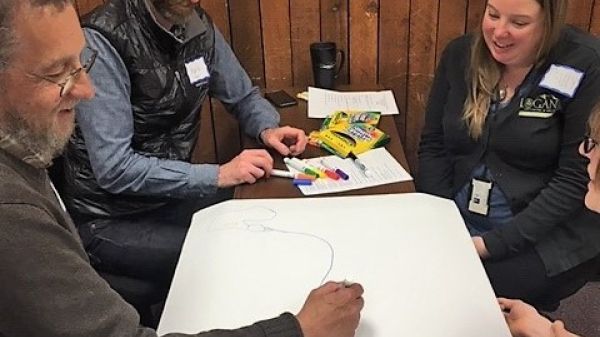Putting it into Practice: Community Engagement Guidelines for Excellence

Few things are more exciting than updating a strategic plan! The Utah Society for Environmental Education (USEE) embarked on this process during the summer of 2018. To ensure that we are supporting the needs all of our environmental education communities here in Utah we decided to conduct focus groups (we called them mini-summits) in 5 distinct regions of the state.
To create these mini-summits we relied heavily on the new Community Engagement Guidelines for Excellence. Here is how we used each of the Five Key Characteristics in this process and the outcomes we achieved:
Key Characteristic #1: Community Centered
Instead of just sending a survey to our members or holding one focus group in our urban core we ensured that we held mini-summits where people were, in their communities. Even though it was a lot of travel on our part it was worth it. We worked to invite individuals who are actively involved in environmental education as well as individuals who may be unfamiliar with our work, people who may not consider themselves environmental educators and potential new partners. This ensured that we weren’t working with the same people we see at every event or conference.
During each mini-summit, we invited participants to share with us the assets in their community and the successes and challenges they see when it comes to environmental education. By framing our conversation around the definition of the participants’ community (that they generated) and the successes we were able to identify challenges in a constructive way.
Each mini-summit culminated in the generation of each community’s top three priorities for environmental education in Utah. These were reflected on at our Annual Environmental Education Conference and will be used to drive our new strategic plan.
Key Characteristic #2: Based on Sound Environmental Education Principals
Each mini-summit was focused on community and this allowed us to get a much clearer picture of EE efforts in the different regions of the state we identified. To facilitate this we used a community mapping activity to get participants to share how they see the place where they live. Working in groups, participants drew their communities, starting with the physical environment followed by descriptive information (economic information and employment, education, infrastructure and public services, etc), and finally other things about their community like environmental awareness and values, local leisure and recreation, community capacity and advocacy, and local identity. These maps were incredible!
As we worked through our agenda we focused on best practices in facilitation. We started each mini-summit by establishing a welcoming and collaborative working environment. We incorporated time for participants to work in small groups, share comments aloud and in writing and provided time for reflection.
Key Characteristic #3: Collaborative and Inclusive
Each mini-summit included time for each participant to share more about the work that they do and the organization(s) they are affiliated with. We also spent time identifying the people who weren’t in the room but that should have a seat at the table. Identifying our EE stakeholders was an amazing experience! It’s incredible to know that our work has support in our state and now we can work more strategically to identify partners.
We also knew that during this process that we would likely hear some difficult feedback and that’s okay! By giving participants a supportive space to voice their opinions we received authentic feedback.
Key Characteristic #4: Oriented Toward Capacity Building and Civic Action
One of the best things that came out of these mini-summits was when participants had “a-ha” moments around new ways to build community, increase capacity and move towards action. As we worked to identify community assets and stakeholders we were able to identify potential collaborations that can help us to increase our impact in different communities, and how different organizations can work together within their own communities!
Some communities are already working on civic action and for some, this may be totally new. Those that are already working on this now are looking forward to sharing their strategies with other communities that share similar traits and with our EE community at large.
Key Characteristic #5: A Long-Term Investment in Change
These mini-summits were the first step in our longer-term planning process. We now have more partners than we had before we started this process! The outcomes were incredible and you can see what we learned at each summit and where we’ll be focusing our efforts here: http://www.usee.org/events/utah-mini-summits-2018
We’re excited that we can now work on a strategic plan that is centered around the needs of our many communities here in the Beehive State!
In addition to the strategic plan, we are working on more ways to engage the regions outside our urban core, including training workshop facilitators in each region and developing regional committees.
Lessons Learned
There were also many lessons learned along the way. If we were to do this again we may include an option for organizations to participate in mini-summits via video conference or other means. We also wish we had more time! Our mini-summits were 3 to 4 hours long on one day. If we go through this process again we may want to offer more than one opportunity to participate, holding summits over the course of a few days in a community.
This process was incredibly useful and it was great to put the Community Engagement Guidelines for Excellence into practice. The Key Characteristics provided a framework that allowed us to make the most of our summits and they also helped us to grow as an organization and professionals. We’re looking forward to continuing to integrating them into our work as a state affiliate.
If you’d like to know more about our process or to see our agendas and activities please contact Alex Porpora, director@usee.org.
